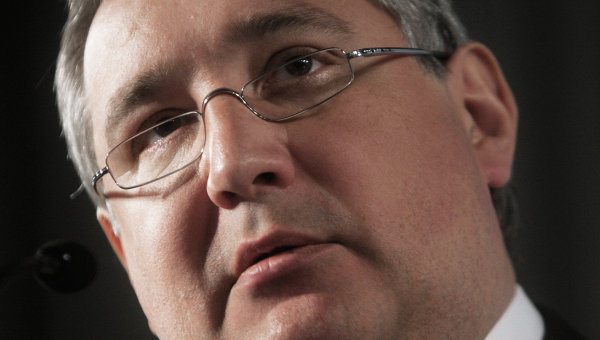
Rogozin Questions Survivability of Russia’s Nuclear Deterrent as Defense Industry Crisis Deepens (Part One)
Publication: Eurasia Daily Monitor Volume: 10 Issue: 125
By:

A number of factors recently coalesced in Moscow’s statements concerning defense and security, military modernization, threat assessment and defense planning that may serve to stimulate further efforts to make more realistic existing plans to modernize the military. However, the persistence of pseudo-paranoia at the heart of the regime permeating the military culture, coupled with innate planning weaknesses, serve to perpetuate a tendency for key figures to ignore the low capacity in the defense industry to deliver the quantum leap sought by President Vladimir Putin. These factors have opened an abyss for Russian defense planning and exposed the near impossible task of military modernization targets. All these factors were signaled by comments from Deputy Defense Minister Dmitry Rogozin, a failed GLONASS satellite launch from Baikonur, the publication by the defense ministry of a “plan of activities” to 2020, and a damning critique of military modernization planning by Makhmut Gareev that provoked a sharp response from an individual close to the planning process (Interfax, July 2).
Addressing a conference in Moscow on June 27, “Be Strong: A Guarantee of Russia’s National Security,” Rogozin delivered the startling claim that “The United States can destroy in a few hours up to 90 percent of our nuclear capability.” Rogozin linked this to the development of highly advanced conventional technologies under the US Global Prompt Strike concept; in his view Russia’s nuclear deterrent could be overwhelmed within the first six hours of conflict. The solution to this apparently unacceptable weakness in Russia’s national security lies in the creation of “autonomous weapons” independent of modern communications. Rogozin made these comments to highlight the technology gap that exists in core technologies between Russia and the West, which he believes leaves Moscow lagging “by decades.” As chairman of the Military Industrial Commission, Rogozin suggests this gap in defense technologies may be narrowed by advancing the work of scientists and technologists to boost the military. “To underestimate the threat to Russia’s security is not just silly,” Rogozin told the conference, promising that Russia will not participate in the “race of military technology” as a “detached observer” (Moskovsky Komsomolets, June 29).
Rogozin’s panache for political rhetoric is not matched by effective management over the beleaguered defense industry, which must deliver such technological breakthroughs. But he offers the paranoid interpretation of a supposed “threat” from the US as justification for pursuing such advances and protecting the nuclear deterrent. Unfortunately, the spectacular 17-second failed launch of a Russian Proton-M rocket from Baikonur on July 2 reminded Moscow’s political-military elite that rhetoric and capacity are two very distant stars in Putin’s calculations. The Proton-M was intended to send three additional GLONASS satellites into orbit to boost efforts to develop Russia’s version of the Global Positioning System (GPS). Predictably Prime Minister Dmitry Medvedev and Rogozin promised recrimination against those responsible for the failure (Interfax, July 2, 3).
In a commentary on the Proton-M failure in Yezhednevnyy Zhurnal, Aleksandr Golts noted that the real problems lie in the manufacturing decline in Russia that has not been reversed by the present political leadership, which fails to reconcile the existence of large collectives with modern market conditions. In addition the loss of production standards has resulted in an inability to manufacture high quality, let alone high-technology, products. Yet, turning to Rogozin, Golts suggests that beneath his bombastic political style is a man that cannot deliver the necessary breakthroughs in the defense industry; in short Rogozin is incompetent. Moreover, the appeal to a possible threat from the US was laid to rest by Golts stressing that this “threat” is not really believed even by the staunchest of Putin’s supporters: “Finally, and probably most importantly, Putin’s state basically has no need for hi-tech manufacturing. Soviet leaders needed cutting-edge science and hi-tech manufacturing—they truly believed that a war with the United States and NATO [North Atlantic Treaty Organization] was likely. Putin and his subordinates happily gabble on about the danger of a quick global strike and the Americans’ ability to destroy Russian nuclear targets. However, they do not seriously believe this,” Golts observed (https://www.ej.ru/?a=note&id=13067#).
In this context, the defense ministry leadership has launched an intensive media public relations campaign designed to shore up the failed Armed Forces reform, and the State Armaments Program (Gosudarstvennaya Programma Vooruzheniya—GPV). Defense Minister Army-General Sergei Shoigu reassures his wider audience that modernization remains on track, while calling a meeting in the defense ministry on July 4 to reach out to university heads to form a new partnership to bring young and bright people into the defense sector to promote a revival in the science of war in Russia (Nezavisimoye Voyennoye Obozreniye, July 5). The default position for the defense leadership, therefore, is to resort to regurgitating figures and percentages to show that a new and modern era awaits the Armed Forces, without explaining either the process underlying the figures or how this can be achieved with an unreformed defense industry.
This has reached a crescendo with the vaunted publication on the defense ministry website of a “de-classified” “plan of activities,” to 2020 designed to show in detail how Moscow plans to develop a modern and effective military. The classified elements relate to the Strategic Rocket Forces, and other areas deemed too sensitive for public scrutiny. The “plan of activities” marks a small breakthrough in the open publication of such figures and provides a semblance of serious defense planning and insight into the targets for the military modernization program to 2020 (https://nvo.ng.ru/concepts/2013-07-05/1_online.html; https://mil.ru/mod_activity_plan/constr.htm). Rossiyskaya Gazeta reported that the chief of the General Staff, Army-General Valeriy Gerasimov, expects “mass delivery” of “advanced” models of arms and equipment to commence in 2016; he had previously suggested it would be in 2015 (Rossiyskaya Gazeta, June 27).
Despite the show of openness in publishing these figures, there is no information on how these numbers are arrived at, or how they will be implemented. Obsessive secrecy surrounding defense planning, combined with the lack of reliable military statistics is further compounded by a dearth of accountability or scrutiny; in short, no one will be accountable if any or all of these targets are not fulfilled. Yet, the roots of failings in the GPV to 2020 have become a matter of controversy between eminent figures close to both military science and modernization planning; and this lies at the heart of the barriers to achieving a modern Russian military.




